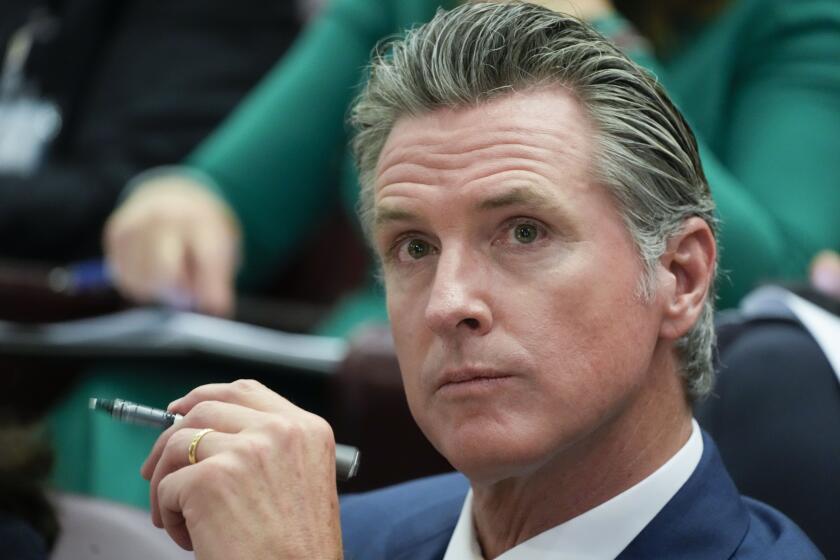Rural, Suburban Areas Ambush Big-City Schools
Turning the tables on urban Democrats, a loosely knit coalition of legislators from the suburban and rural areas of the state exerted new-found muscle in the Assembly this week and won support for a Proposition 98 school funding package that left cities such as Los Angeles out in the cold.
The deal, announced Tuesday, ended an eight-day stalemate and led to Assembly passage of a nearly $50-billion version of the state budget.
While legislators from both sides of the aisle warn about making too much of the vote, some lawmakers are calling the deal “historic” because--if Gov. George Deukmejian and the Senate agree--it will free up hundreds of millions for money-starved suburban and rural schools by directing money away from urban districts.
At stake is the new money, roughly $1.4 billion over two budget years, being generated for schools by the landmark school funding initiative Proposition 98, which was approved by voters last Nov. 8.
The Assembly plan to implement Proposition 98, to be amended into a long-term school funding bill, was unusual in that it bypassed the Education and Budget committees controlled by big-city Democrats. That was possible because Assembly Speaker Willie Brown (D-San Francisco) set up a special team of negotiators to draft the proposal.
Once agreed upon by the special team, the plan was informally ratified in a budget vote marked by a rare bipartisan alliance. Casting “no” votes were such members of the urban Los Angeles delegation as Terry B. Friedman, Teresa P. Hughes, Richard Katz, Burt Margolin, Lucille Roybal-Allard and Maxine Waters, all of whom could normally be counted on to vote for a budget bill.
Friedman, expressing concerns shared by other members of the Los Angeles delegation, said he refused to vote for the budget because he believed that the school aid package was “vindictive” and “a purposeful effort to get L.A.”
Assemblywoman Hughes, the chairwoman of the Assembly Education Committee, which was bypassed by the negotiators who put together the plan, said: “I’m not very pleased. Los Angeles is really getting worked over.”
But while the Los Angeles Democrats were crying foul, normally powerless legislators from Orange County, suburban cities such as Glendale and rural and farming communities in California’s Central Valley were praising the vote as “historic” because it recognized for the first time in recent years that school finance was out of kilter, with big-city schools drawing most of the dollars.
Assemblywoman Doris Allen (R-Cypress), noting that Orange County schools will get more than $69 million as a result of the agreement, called it a “foundation for fairness” for future education funding.
Assemblyman Pat Nolan (R-Glendale), who played a leading role in putting the deal together, said Republicans for years have complained that fast-growing suburban and rural communities were being shortchanged in the annual division by political leaders of the roughly $15 billion a year the state gives to school districts. Because they had no hard numbers to back up their contention, two years ago Republicans ordered a study of education expenditures. This year, they got their first report.
What the study showed was that when all the various special state financial aid programs were added up, the Los Angeles Unified School District was receiving $1,045 per pupil, San Jose Unified was getting $1,346 for each student, and San Francisco, Oakland and San Diego were getting $934, $810 and $702 respectively.
Cries of Outrage
Those numbers led to cries of outrage when lawmakers compared them to much lower figures for school districts outside the big cities. For example, in Los Angeles County, Alhambra schools were receiving $232 per pupil, while each student in Glendale was being backed by $192 in state dollars. Elsewhere, Fresno was receiving $432 per pupil; Riverside, $277; Sacramento, $442, and Chula Vista, in San Diego County, $293 per student.
“When we totaled the figures up, it confirmed what we had felt all along was happening. In fact, the disparities were far worse than we had thought,” Nolan said.
Aside from the question of fairness, Republicans also had the law on their side. In 1971, the California Supreme Court in a landmark decision ruled that the state’s system of financing public education was illegal because there was a huge disparity in funding between rich and poor school districts. As a result of the ruling, the Legislature enacted a series of laws designed to bring about equality in funding, but the figures turned up by Assembly Republicans showed that a huge gap still existed.
Those close to the issue give many reasons for the disparities in funding.
State funding for schools is done in a variety of ways, from unrestricted financial aid based solely on the number of students in each district to grants made in support of more than 50 different special programs, each one designed to meet different needs.
Separate financial aid programs were created to provide extra assistance to gifted students, slow learners and poor readers. Others, with a broader sweep, were put together to provide extra financial aid to school districts with major problems, such as those under court order to desegregate or those that have large concentrations of poor and foreign-speaking students.
The Los Angeles Unified School district, by far the largest school district in the state, got in on the ground floor of all of the programs and was a magnet, pulling in money for just about everything.
The problem for other districts was that as a result of a series of lean state budgets in the 1980s, little new money was added to finance the special programs. Those districts already receiving the aid continued to get the money, but schools in newly emerging areas of the state basically were shut out.
Assemblyman Charles Bader (R-Pomona), in an emotional appeal to Democrats on the floor of the Assembly, complained that “kids from identical circumstances receive a fraction of support that other kids receive. . . . It isn’t fair. It isn’t right. It’s not educationally sound.”
Helping to galvanize the legislators was the lucrative wage settlement the Los Angeles Unified School District recently gave its teachers. The generous settlement, which will boost teacher wages by 24% by 1990, rankled numerous legislators, who complained that other districts could not afford to pay their teachers as well, even though housing prices and living expenses in Glendale, Alhambra and other communities are comparable to those in Los Angeles.
The financing plan promoted by Republicans would take away some of the money that would have helped Los Angeles meet its new payroll, but legislators insist that the district will still get enough to finance the strike settlement package.
(Even though Los Angeles Unified, with nearly 600,000 students, will get less than most other districts on an average per-pupil basis, it would still get a lump sum payment of $50.7 million under the equalization plan. By contrast, Orange County’s 28 school districts, with 348,000 students, would split a total of $69.4 million. On top of that, school districts statewide would divide another $521 million in unrestricted funds that they could spend for such things as payroll during the current and upcoming budget years.)
Even though Nolan, Bader and other Republicans had obvious sympathy from Democrats who represent similar suburban and agricultural districts, the GOP legislators got nowhere until they took the extraordinary action of refusing to vote for the proposed state budget when it came up for a procedural vote June 5.
What followed was an eight-day stalemate during which Republicans circulated computer printouts comparing education funding district by district. The disparities in funding cut across party lines. Democrats in suburban and rural communities saw that the school districts they represented were as bad off as districts represented by their GOP counterparts.
Nolan said: “We found that money was being unfairly channeled to certain large districts at the expense of students around the rest of the state. The printouts sent shock waves through the Democratic Caucus.”
Normal Democratic team players such as Assemblyman Patrick Johnston (D-Stockton) were incensed. When negotiators came up with a plan to help rural and suburban districts, Johnston said he did not have any sympathy for Los Angeles because “they’ve pigged out so much over the years.”
Assemblyman Rusty Areias (D-Los Banos), who once led an informal coalition of rural legislators that was organized to get a better deal for farming communities, said, “The rural and suburban districts have really been getting screwed over.”
As a result of the stalemate, a negotiating team of four lawmakers from each party was formed to come up with a plan.
The agreement that came together is designed to make school funding more equal than it has been by directing a disproportionate share of Proposition 98 funds to school districts that are now receiving less than others.
For example, the Los Angeles Unified School District’s share of the new money would amount to $86 per pupil. Oakland would get $93 per student; San Francisco $109; San Diego $146 and San Jose $177. The statewide average would be $155 per student. But many districts would receive more than that, with the Anaheim Union High School District targeted for $266 per pupil; Glendale Unified, $223; Lancaster Elementary, $267, and so on.
On a countywide basis, Los Angeles County schools would receive an average of $130 per student when the Proposition 98 pie is divided up, while other Southern California counties would get a split of the money, on a per-pupil basis, this way: Orange County, $199; San Diego, $180; Santa Barbara, $173; Riverside, $165; Ventura, $198; Imperial, $217, and Kern, $139.
Overall, when all the state dollars are counted, big-city school districts such as Los Angeles would still be receiving hundreds of dollars more per pupil. But the Proposition 98 plan would move the “have-nots” much closer to the “haves,” according to Nolan. “We won’t be at equal dollars per student, but this is a major step forward. The commitment is that over the next three years we will move the bottom-level districts up to the statewide average. That’s a historic commitment.”
Nolan and other lawmakers say they do not see broader political implications from the alliance of Republicans and Democrats that came together on the proposed Proposition 98 funding plan. They do not see the same Republicans and Democrats forming a bloc that could be counted on to pass other major bills.
“The reason it worked this time is that we had so much new money to spend. We had a chance to correct things. Some schools get a hell of a lot more money than others. The goal was to make expenditures per child more equal. That’s it,” Assemblyman Sam Farr (D-Carmel) said.
But at least one rural Democrat, Areias, believes that the vote was the first of many to come that reflects changing demographics in California. He points to the rapid population growth in suburban and rural regions of the state.
The state Department of Finance, in a recent report, said it expects 5 million new households to be formed in California by the year 2020. And with little land left in central cities, most of the growth is expected to be in new suburbs and rural areas.
Areias, one of the so-called Gang of Five rebellious Democrats who last year tried to topple Speaker Brown, said:
“The agreement is an indication of the political clout that is moving into the suburban and rural areas. When we reapportion after the 1990 census, rural and suburban areas are going to get more representation and inner cities are going to lose political power.”
PROPOSED STATE AID ALLOTMENTS
Chart shows what each Los Angeles County school district receives per pupil for the more than 50 special education programs financed by the state. First column of figures shows what districts now receive. Second shows additional amount they would receive under plan approved by Assembly this week. These sums do not include the base per-pupil funding each district receives.
STATE AID PROPOSED SCHOOL DISTRICT PER PUPIL INCREASE ABC Unified $429 $173 Alhambra City Elementary 232 159 Alhambra City High 427 115 Antelope Valley Union High 385 236 Arcadia Unified 87 205 Azusa Unified 412 201 Baldwin Park Unified 550 164 Bassett Unified 566 176 Bellflower Unified 329 171 Beverly Hills Unified 184 65 Bonita Unified 224 220 Burbank Unified 220 184 Castaic Union 281 165 Centinela Valley Union High 544 196 Charter Oak Unified 320 183 Claremont Unified 349 199 Compton Unified 716 104 Covina Valley Unified 347 183 Culver City Unified 365 79 Downey Unified 318 211 Duarte Unified 322 213 East Whittier City Elementary 228 291 Eastside Union Elementary 442 94 El Monte City 295 151 El Monte Union High 925 87 El Rancho Unified 451 192 El Segundo Unified 154 63 Garvey Elementary 342 110 Glendale Unified 192 223 Glendora Unified 198 200 Gorman Elementary 486 116 Hacienda La Puente Unified 616 155 Hawthorne Elementary 165 262 Hermosa Beach City Elementary 205 47 Hughes-Elizabeth Lakes Union 375 175 Inglewood Unified 448 78 Keppel Union Elementary 209 105 La Canada Unified 191 192 Lancaster Elementary 144 267 Las Virgenes Unified 174 182 Lawndale Elementary 285 190 Lennox Elementary 300 241 Little Lake City Elementary 287 182 Long Beach Unified 453 172 Los Angeles Unified 1,045 86 Los Nietos Elementary 409 108 Lowell Joint Elementary 273 199 Lynwood Unified 366 167 Manhattan Beach City Elementary 184 89 Monrovia Unified 466 177 Montebello Unified 445 78 Mountain View Elementary 349 115 Newhall Elementary 170 248 Norwalk-La Mirada Unified 422 171 Palmdale Elementary 149 278 Palos Verdes Peninsula Unified 134 136 Paramount Unified 301 160 Pasadena City Unified 498 88 Pomona Unified 484 131 Redondo Beach City Elementary 183 228 Rosemead Elementary 206 253 Rowland Unified 260 202 San Gabriel Elementary 176 240 San Marino Unified 111 184 Santa Monica-Malibu Unified 238 97 Saugus Union Elementary 208 259 Soledad-Agua Dulce Union Elementary 338 125 South Bay Union High 516 168 South Pasadena Unified 160 214 South Whittier Elementary 309 110 Sulphur Springs Union Elementary 350 207 Temple City Unified 152 202 Torrance Unified 421 178 Valle Lindo Elementary 294 132 Walnut Valley Unified 292 212 West Covina Unified 291 151 Westside Union Elementary 190 233 Whittier City 280 179 Whittier Union High 499 88 William S. Hart Union High 309 238 Wilsona Elementary 133 165 Wiseburn Elementary 160 74
Source: Assembly Ways and Means Committee
More to Read
Get the L.A. Times Politics newsletter
Deeply reported insights into legislation, politics and policy from Sacramento, Washington and beyond. In your inbox three times per week.
You may occasionally receive promotional content from the Los Angeles Times.






